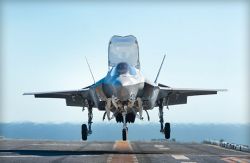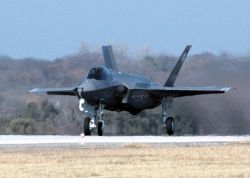F-35 Software Glitches To Delay Deliveries, Says US Government Accountability Office

The US Marine Corps F-35 Joint Strike Fighter program would be delayed further due to glitches in software development and testing, according to a Government Accountability Office (GAO) report.
Earlier reports said the F-35s is scheduled to reach “initial operating capability” by mid-2015. However, the new report says that full delivery of first F-35 "capability" may come a year late.
The F-35 fighter has become one of the most expensive programs taken on by the Pentagon with over $84 billion already spent before a single aircraft has been delivered. But the final cost can be approximately $397 billion, with individual F-35B jets costing $196.5 million each.
The GAO reports say the cost may escalate further due to cracks found in a number of aircraft currently in testing and a resulting redesign of some of the components.
The physical problems with the aircraft have not been the only source of delays—or even the biggest. There have also been several high-profile software problems with the F-35. One was an error in the fighter’s computer system, the Autonomic Logistics Information System, that associated the wrong part numbers with aircraft components and recommended grounding planes after repairs had been made.
The US Marine Corps Lt. General Robert Schmidle, the Deputy Commandant of the Marine Corps for Aviation, was quoted as saying by CBS’ 60 Minutes in February, “We need to have the ability to override the algorithms that are built into that system to determine whether an aircraft is safe to fly or not.”
Another source of woes has been F-35’s expensive, high-tech helmet. The helmet is the pilot’s primary display for all instrumentation and sensor data, using augmented reality technology and a collection of video cameras and other sensor data to allow the pilot to virtually look through the aircraft’s body. But “jitter” in the helmet—shaking of the displayed data caused by a too-faithful response to the plane’s vibrations—caused the Defense Department to briefly order work on a backup helmet based on older technology.
The F-35 Joint Program office cancelled that backup plan last October after the primary helmet’s problems were largely resolved.
But these were just the most visible issues, the GAO reported. “Challenges in development and testing of mission systems software continued through 2013, due largely to delays in software delivery, limited capability in the software when delivered, and the need to fix problems and retest multiple software versions,” the GAO’s auditors of the program reported. “The Director of Operational Test and Evaluation (DOT&E) predicts delivery of warfighting capabilities could be delayed by as much as 13 months. Delays of this magnitude will likely limit the warfighting capabilities that are delivered to support the military services’ initial operational capabilities—the first of which is scheduled for July 2015—and at this time it is not clear what those specific capabilities will be because testing is still ongoing.”
The F-35 Joint Program office acknowledged the ongoing problems with the fighter’s software in a statement from Air Force Major General Christopher Bogdan, who heads the program. “Software continues to remain our number one technical risk on the program, and we have instituted disciplined systems engineering processes to address the complexity of writing, testing, and integrating software,” Bogdan said. “There were no surprises in this [GAO] report and all of the items mentioned were well known to us, the F-35 partners and our industry team.”












